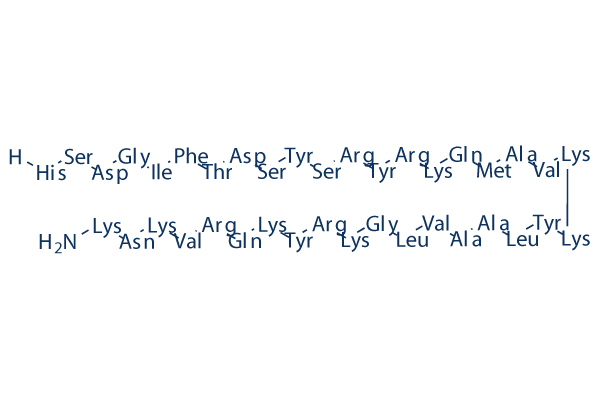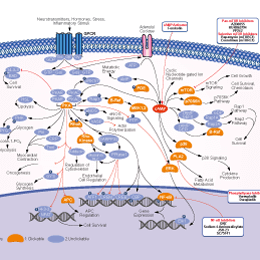
- Bioactive Compounds
- By Signaling Pathways
- PI3K/Akt/mTOR
- Epigenetics
- Methylation
- Immunology & Inflammation
- Protein Tyrosine Kinase
- Angiogenesis
- Apoptosis
- Autophagy
- ER stress & UPR
- JAK/STAT
- MAPK
- Cytoskeletal Signaling
- Cell Cycle
- TGF-beta/Smad
- DNA Damage/DNA Repair
- Compound Libraries
- Popular Compound Libraries
- Customize Library
- Clinical and FDA-approved Related
- Bioactive Compound Libraries
- Inhibitor Related
- Natural Product Related
- Metabolism Related
- Cell Death Related
- By Signaling Pathway
- By Disease
- Anti-infection and Antiviral Related
- Neuronal and Immunology Related
- Fragment and Covalent Related
- FDA-approved Drug Library
- FDA-approved & Passed Phase I Drug Library
- Preclinical/Clinical Compound Library
- Bioactive Compound Library-I
- Bioactive Compound Library-Ⅱ
- Kinase Inhibitor Library
- Express-Pick Library
- Natural Product Library
- Human Endogenous Metabolite Compound Library
- Alkaloid Compound LibraryNew
- Angiogenesis Related compound Library
- Anti-Aging Compound Library
- Anti-alzheimer Disease Compound Library
- Antibiotics compound Library
- Anti-cancer Compound Library
- Anti-cancer Compound Library-Ⅱ
- Anti-cancer Metabolism Compound Library
- Anti-Cardiovascular Disease Compound Library
- Anti-diabetic Compound Library
- Anti-infection Compound Library
- Antioxidant Compound Library
- Anti-parasitic Compound Library
- Antiviral Compound Library
- Apoptosis Compound Library
- Autophagy Compound Library
- Calcium Channel Blocker LibraryNew
- Cambridge Cancer Compound Library
- Carbohydrate Metabolism Compound LibraryNew
- Cell Cycle compound library
- CNS-Penetrant Compound Library
- Covalent Inhibitor Library
- Cytokine Inhibitor LibraryNew
- Cytoskeletal Signaling Pathway Compound Library
- DNA Damage/DNA Repair compound Library
- Drug-like Compound Library
- Endoplasmic Reticulum Stress Compound Library
- Epigenetics Compound Library
- Exosome Secretion Related Compound LibraryNew
- FDA-approved Anticancer Drug LibraryNew
- Ferroptosis Compound Library
- Flavonoid Compound Library
- Fragment Library
- Glutamine Metabolism Compound Library
- Glycolysis Compound Library
- GPCR Compound Library
- Gut Microbial Metabolite Library
- HIF-1 Signaling Pathway Compound Library
- Highly Selective Inhibitor Library
- Histone modification compound library
- HTS Library for Drug Discovery
- Human Hormone Related Compound LibraryNew
- Human Transcription Factor Compound LibraryNew
- Immunology/Inflammation Compound Library
- Inhibitor Library
- Ion Channel Ligand Library
- JAK/STAT compound library
- Lipid Metabolism Compound LibraryNew
- Macrocyclic Compound Library
- MAPK Inhibitor Library
- Medicine Food Homology Compound Library
- Metabolism Compound Library
- Methylation Compound Library
- Mouse Metabolite Compound LibraryNew
- Natural Organic Compound Library
- Neuronal Signaling Compound Library
- NF-κB Signaling Compound Library
- Nucleoside Analogue Library
- Obesity Compound Library
- Oxidative Stress Compound LibraryNew
- Plant Extract Library
- Phenotypic Screening Library
- PI3K/Akt Inhibitor Library
- Protease Inhibitor Library
- Protein-protein Interaction Inhibitor Library
- Pyroptosis Compound Library
- Small Molecule Immuno-Oncology Compound Library
- Mitochondria-Targeted Compound LibraryNew
- Stem Cell Differentiation Compound LibraryNew
- Stem Cell Signaling Compound Library
- Natural Phenol Compound LibraryNew
- Natural Terpenoid Compound LibraryNew
- TGF-beta/Smad compound library
- Traditional Chinese Medicine Library
- Tyrosine Kinase Inhibitor Library
- Ubiquitination Compound Library
-
Cherry Picking
You can personalize your library with chemicals from within Selleck's inventory. Build the right library for your research endeavors by choosing from compounds in all of our available libraries.
Please contact us at [email protected] to customize your library.
You could select:
- Antibodies
- Bioreagents
- qPCR
- 2x SYBR Green qPCR Master Mix
- 2x SYBR Green qPCR Master Mix(Low ROX)
- 2x SYBR Green qPCR Master Mix(High ROX)
- Protein Assay
- Protein A/G Magnetic Beads for IP
- Anti-Flag magnetic beads
- Anti-Flag Affinity Gel
- Anti-Myc magnetic beads
- Anti-HA magnetic beads
- Magnetic Separator
- Poly DYKDDDDK Tag Peptide lyophilized powder
- Protease Inhibitor Cocktail
- Protease Inhibitor Cocktail (EDTA-Free, 100X in DMSO)
- Phosphatase Inhibitor Cocktail (2 Tubes, 100X)
- Cell Biology
- Cell Counting Kit-8 (CCK-8)
- Animal Experiment
- Mouse Direct PCR Kit (For Genotyping)
- New Products
- Contact Us
PACAP 1-38
Synonyms: Pituitary Adenylate Cyclase Activating Polypeptide 38
PACAP 1-38 (Pituitary Adenylate Cyclase Activating Polypeptide 38) is a highly potent PACAP receptor agonist (Kd = 100 pM). It stimulates adenylate cyclase and phagocytosis.

PACAP 1-38 Chemical Structure
CAS No. 137061-48-4
Purity & Quality Control
Batch:
Purity:
99.98%
99.98
PACAP 1-38 Related Products
| Related Targets | AC EPAC1 EPAC2 PACAP receptor | Click to Expand |
|---|---|---|
| Related Products | Forskolin (Colforsin) SQ22536 ESI-09 Bithionol PACAP 6-38 acetate HJC0350 | Click to Expand |
| Related Compound Libraries | FDA-approved Drug Library Natural Product Library Bioactive Compound Library-I GPCR Compound Library | Click to Expand |
Signaling Pathway
Biological Activity
| Description | PACAP 1-38 (Pituitary Adenylate Cyclase Activating Polypeptide 38) is a highly potent PACAP receptor agonist (Kd = 100 pM). It stimulates adenylate cyclase and phagocytosis. | ||||||
|---|---|---|---|---|---|---|---|
| Targets |
|
| In vitro | ||||
| In vitro | PACAP 1-38 has potent, efficacious, and sustained stimulatory effects on sympathetic neuronal NPY and catecholamine production[1]. It is a pleiotropic neuropeptide, exhibiting a variety of biologic actions, including activities as a neurotransmitter, neuromodulator, neurotrophic factor, as well as an immunomodulator, in immune cells through its effect on MAPK signaling and modulation of activation of NFκB. PACAP 1-38 dramatically prevents injury of cultured renal proximal tubule cells caused by myeloma light chains through suppression of proinflammatory cytokines production, by inhibiting p38 MAPK and translocation of NFκB via both PAC1 and VPAC1 receptors. PACAP38 inhibits myeloma cell growth directly and may also indirectly by suppressing production of the growth factor, IL-6, from bone marrow stromal cells, that is stimulated by adhesion of myeloma cells. PACAP38 suppressed release of both IL-6 and TNFα dose dependently[2]. |
|||
|---|---|---|---|---|
| Cell Research | Cell lines | human renal proximal tubule cell line | ||
| Concentrations | 0.0001-100 nM | |||
| Incubation Time | 3 days | |||
| Method | Human renal proximal tubule cells plated onto 6-well tissue culture plates are grown at 37°C in DRM-23E medium supplemented with 0.5% (vol/vol) FBS in an incubator for 24 hours. After prewashing with serum-free medium, the cells are incubated with κ-LC (1.5 mg/ml, ∼ 50 μM) for 3 days in the presence and absence of various concentrations of PACAP38 as well as kinase and transcription factor inhibitors. Cell viability is determined by trypan blue exclusion assays; in all experiments, at least 85% of cells remain viable. After exposure to test substances, culture supernatants are harvested and stored at –70°C for cytokine assays. After the medium is removed, the cells are washed with ice-cold PBS, and proteins are extracted by lysing cells with Sigma Mammalian Cell Lysis Reagents. Lysates are scraped and passed through a 21-gauge needle to shear DNA, and centrifuged at 12 000g for 10 minutes at 4°C. Finally, supernatants are harvested and used for kinase studies. |
|||
| In Vivo | ||
| In vivo | PACAP38 is capable of inhibiting light chain-induced cytokine expression with a great potency and prevented the resulting cell damage in vivo. However, PACAP is also considered as an autoregulatory factor for certain tumors, stimulating their growth in an autocrine fashion[2]. |
|
|---|---|---|
| Animal Research | Animal Models | Male Sprague-Dawley rats |
| Dosages | 2 nmol/10 mL | |
| Administration | i.v. | |
Chemical Information & Solubility
| Molecular Weight | 4534.26 | Formula | C203H331N63O53S |
| CAS No. | 137061-48-4 | SDF | Download PACAP 1-38 SDF |
| Smiles | CCC(C)C(NC(=O)CNC(=O)C(CC(O)=O)NC(=O)C(CO)NC(=O)C(N)CC1=CN=C[NH]1)C(=O)NC(CC2=CC=CC=C2)C(=O)NC(C(C)O)C(=O)NC(CC(O)=O)C(=O)NC(CO)C(=O)NC(CC3=CC=C(O)C=C3)C(=O)NC(CO)C(=O)NC(CCCNC(N)=N)C(=O)NC(CC4=CC=C(O)C=C4)C(=O)NC(CCCNC(N)=N)C(=O)NC(CCCCN)C(=O)NC(CCC(N)=O)C(=O)NC(CCSC)C(=O)NC(C)C(=O)NC(C(C)C)C(=O)NC(CCCCN)C(=O)NC(CCCCN)C(=O)C(=O)C(CC5=CC=C(O)C=C5)NC(=O)C(CC(C)C)NC(=O)C(C)NC(=O)C(C)NC(=O)C(NC(=O)C(CC(C)C)NC(=O)CNC(=O)C(CCCCN)NC(=O)C(CCCNC(N)=N)NC(=O)C(CC6=CC=C(O)C=C6)NC(=O)C(CCCCN)NC(=O)C(CCC(N)=O)NC(=O)C(CCCNC(N)=N)NC(=O)C(NC(=O)C(CCCCN)NC(=O)C(CC(N)=O)NC(=O)C(CCCCN)NN)C(C)C)C(C)C | ||
| Storage (From the date of receipt) | |||
|
In vitro |
Water : 100 mg/mL |
Molecular Weight Calculator |
|
In vivo Add solvents to the product individually and in order. |
In vivo Formulation Calculator |
||||
Preparing Stock Solutions
Molarity Calculator
In vivo Formulation Calculator (Clear solution)
Step 1: Enter information below (Recommended: An additional animal making an allowance for loss during the experiment)
mg/kg
g
μL
Step 2: Enter the in vivo formulation (This is only the calculator, not formulation. Please contact us first if there is no in vivo formulation at the solubility Section.)
% DMSO
%
% Tween 80
% ddH2O
%DMSO
%
Calculation results:
Working concentration: mg/ml;
Method for preparing DMSO master liquid: mg drug pre-dissolved in μL DMSO ( Master liquid concentration mg/mL, Please contact us first if the concentration exceeds the DMSO solubility of the batch of drug. )
Method for preparing in vivo formulation: Take μL DMSO master liquid, next addμL PEG300, mix and clarify, next addμL Tween 80, mix and clarify, next add μL ddH2O, mix and clarify.
Method for preparing in vivo formulation: Take μL DMSO master liquid, next add μL Corn oil, mix and clarify.
Note: 1. Please make sure the liquid is clear before adding the next solvent.
2. Be sure to add the solvent(s) in order. You must ensure that the solution obtained, in the previous addition, is a clear solution before proceeding to add the next solvent. Physical methods such
as vortex, ultrasound or hot water bath can be used to aid dissolving.
Tech Support
Answers to questions you may have can be found in the inhibitor handling instructions. Topics include how to prepare stock solutions, how to store inhibitors, and issues that need special attention for cell-based assays and animal experiments.
Tel: +1-832-582-8158 Ext:3
If you have any other enquiries, please leave a message.
* Indicates a Required Field
Tags: buy PACAP 1-38 | PACAP 1-38 supplier | purchase PACAP 1-38 | PACAP 1-38 cost | PACAP 1-38 manufacturer | order PACAP 1-38 | PACAP 1-38 distributor







































